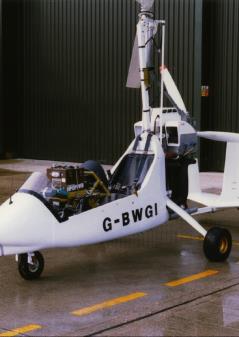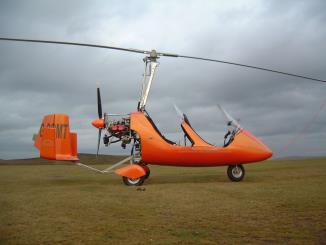New gyroplane design standards improve flight safety
Submitting Institution
University of GlasgowUnit of Assessment
General EngineeringSummary Impact Type
TechnologicalResearch Subject Area(s)
Engineering: Interdisciplinary Engineering
Summary of the impact
As a direct result of University of Glasgow research, there have been no
deaths in a gyroplane accident in the UK since 2009. Previously,
gyroplanes (also known as autogyros) had a questionable safety record.
Following fifteen years of comprehensive studies, researchers recommended
innovative new design standards to the Civil Aviation Authority. These
recommendations led to the introduction of new civil airworthiness
requirements in the UK, subsequently adopted by Australia and Canada. The
implementation of these revised regulations has forced gyroplane
manufacturers to change their designs. Close to 2000 machines have been
produced since this design change, revolutionising gyroplane safety
worldwide.
Underpinning research
A gyroplane is a type of rotorcraft that is supported in flight by a
rotor providing lift. Unlike a helicopter, a gyroplane's rotor is driven
only by aerodynamic forces (air pressure) once in flight, and thrust is
provided by an engine-powered propeller similar to that of a fixed-wing
aircraft. Following a spate of unexplained fatal accidents involving light
gyroplanes between 1989 and 1991, the UK Air Accident Investigation Branch
recommended the funding of a research programme to improve the
understanding of aerodynamics and flight mechanics of gyroplanes. A call
for tenders was issued by the UK Civil Aviation Authority (CAA). The team
of Dr Douglas Thomson (Senior Lecturer Aerospace Sciences, 1986-present)
and Dr Stewart Houston (Senior Lecturer Aerospace Sciences, 1991-present),
from the School of Engineering at the University of Glasgow, were awarded
the contract in 1992. Thomson and Houston were well-placed to carry out
this research, with 22 years of proven rotorcraft experience including
wind tunnel testing, simulation and modelling expertise between them.
At the outset of the research programme in 1993, the aim was to establish
the general stability characteristics of a gyroplane and then determine
which aspects of its design were most influential on its dynamic
characteristics [1, 2]. The research consisted of mathematical modelling,
development of simulations, wind tunnel testing and flight tests. Over the
next 15 years the research team secured a series of seven research
contracts from the CAA to continue to develop the understanding of
gyroplane behaviour [3, 4]. The primary output of these research contracts
with the CAA was an engineering mathematical model of the aircraft so that
design features, changes and hypothetical situations could be examined
without the need for physical testing. The mathematical model, RASCAL, is
a high-order, high-fidelity simulation tool previously developed at the
University of Glasgow to investigate helicopter-related problems. For the
CAA-funded research it was reconfigured to represent the gyroplane — the
first time such a comprehensive model had been applied to gyroplanes.
Ongoing research checked the fidelity of the model against flight test
data gathered during a number of campaigns with two fully-instrumented
light gyroplanes using specialised flight test techniques involving
stylised and unusual control inputs [3]. The resulting data was analysed
using sophisticated mathematical analysis techniques, demonstrating that
the vertical location of the centre of mass in relation to the assumed
propeller thrust line is the key parameter leading to aircraft
instability. This was a particularly important finding since the
incorporation of more powerful engines and larger propellers into
gyroplane design had resulted in the propeller being raised to ensure
clearance with the craft's keel, thereby raising the centre of mass and
reducing stability.
The key research findings from this extensive body of work include:
- Gyroplane aerodynamic properties are relatively insensitive to
configurational changes [1, 2]. This was the result of wind tunnel
testing.
- Gyroplanes exhibit a mix of stability characteristics typical of those
of fixed wing aircraft and helicopters [5, 6].
- Raising the propeller location to ensure clearance with the craft's
keel could result in aircraft instability.
- A centre of gravity location above the propeller thrust line, created
by lowering the keel, has a significant stabilising effect (on the pitch
stability mode).
The key output was the 2008 report to the CAA recommending gyroplane
design changes including lowering the keel. The report's findings were
integrated into CAA's current British Civil Airworthiness Requirements
(BCAR) Section T: Light Gyroplanes, legislation which governs the safety
of gyroplanes.
References to the research
1. Houston, S.S. (1996) Longitudinal Stability of Gyroplanes. The
Aeronautical Journal, 100 (991), pp. 1-6. (Available from HEI) *
2. Houston, S.S. (1998) Identification of Autogyro Longitudinal Stability
and Control Characteristics. AIAA Journal of Guidance, Control and
Dynamics 21(3), pp. 391-399,
(doi:10.2514/2.4271)
3. Thomson, D.G., and Houston, S.S. (2005) Application of parameter
estimation to improved autogyro simulation model fidelity. Journal of
Aircraft, 42, pp. 33-40. (doi:10.2514/1.3964)
4. Houston, S.S. (2002) Analysis of rotorcraft flight dynamics in
autorotation. Journal of Guidance Control and Dynamics, 25, pp.
33-39. (doi:10.2514/2.4872)
(Available from HEI) *
5. Bagiev, M., and Thomson, D.G. (2009) Handling qualities evaluation of
an autogiro against the existing rotorcraft criteria. Journal of Aircraft,
46(1), pp. 168-174. ISSN 0021-8669/
(doi:10.2514/1.37289).
*
* best indicators of research quality
Details of the impact
Over a period of 15 years, Thomson and Houston developed models and
simulations which greatly improved the general understanding of gyroplane
aerodynamics and behaviour for manufacturers, regulators and operators
across the world.
Implementation of new civil airworthiness requirements in the UK
As a result of this comprehensive University of Glasgow research,
stringent requirements are now in place to ensure that only airworthy
gyroplanes are permitted to fly in the UK. Reports submitted by Thomson
and Houston led directly to the CAA's current British Civil Airworthiness
Requirements (BCAR) Section T: Light Gyroplanes, legislation which governs
the safety of gyroplanes.
Following a first set of flight trials, Thomson and Houston carried out
an analysis of existing BCAR Section T requirements to inform their next
phase of research. As the research progressed, regular contractor reports
were submitted to the CAA, enabling a process of continual revision of the
requirements. University of Glasgow recommendations relating to gyroplane
longitudinal stability were incorporated in 2005. In 2011, the
requirements were updated again, introducing a number of changes arising
from the increased understanding of the flight characteristics of
gyroplanes gained by the University's ongoing research into stability and
an investigation into rotor dynamics.
International influence of BCAR Section T
Internationally, the 2011 revised requirements have been adopted in
Australia and Canada. In Germany, although not adopted, they are treated
as advisory requirements.
The implementation of revised regulations for gyroplane design and
modifications forced the main European manufacturer, AutoGyro of Germany,
to change its designs. Between AutoGyro and RotorSport UK, the leading UK
gyroplane manufacturer, close to 2,000 machines have been produced since
this design change and are in use worldwide. Even in countries where the
UK CAA standards have not been applied, the research is well-known and
also influences gyroplane design. Visual evidence of this can be seen in
modern gyroplanes where dropped or stepped keels, inclined powerplant
thrust lines or lowered powerplant installations can be found. These
changes improve the aerodynamic characteristics of the gyroplane, thereby
improving safety for the pilots and passengers.
 Original straight keel. When the propeller size increased it was necessary to raise the height of the propeller to avoid the keel — this introduced instability.
Original straight keel. When the propeller size increased it was necessary to raise the height of the propeller to avoid the keel — this introduced instability.
 Dropped/stepped keel introduced as a result of the University of Glasgow recommendations to CAA, adopted in BCAR Section T. The dropped keel enables the propeller to remain low, maintaining stability. (Image courtesy of RotorSport UK Ltd)
Dropped/stepped keel introduced as a result of the University of Glasgow recommendations to CAA, adopted in BCAR Section T. The dropped keel enables the propeller to remain low, maintaining stability. (Image courtesy of RotorSport UK Ltd)
Reduced fatalities in the UK
This research has had a direct impact on lowering light gyroplane fatal
accidents. The fatal accident rate between 2000 and 2009 was 1 per 2500
hours. Since 2009, there have been no fatal accidents in the UK. For this
period, most of the UK fleet are of modern designs influenced by the
University of Glasgow research (there has been one fatality in the sector
due to deliberate illegal action).
The UK Air Accident Investigation Branch regularly cites the University
of Glasgow research in accident reports. In fact, Thomson and Houston's
mathematical model, developed since 1993, has been used in simulations to
assist in the investigation of every fatal accident since 1996.
Sources to corroborate the impact